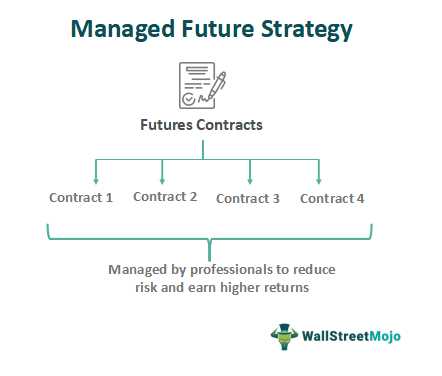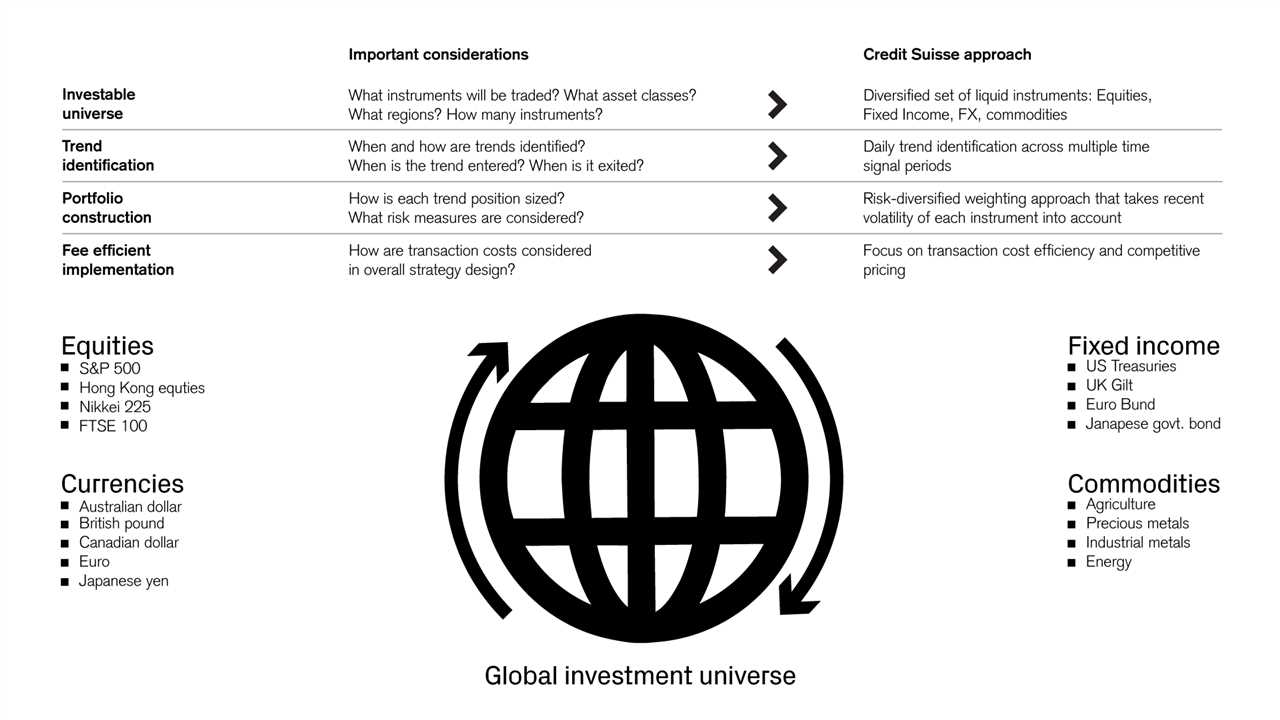Benefits of Managed Futures

Managed futures offer a range of benefits for investors looking to diversify their portfolios and potentially achieve higher returns. Here are some key advantages of investing in managed futures:
Diversification
Managed futures provide an opportunity to diversify investments beyond traditional asset classes such as stocks and bonds. By including managed futures in a portfolio, investors can potentially reduce overall risk and increase the potential for returns.
Potential for Positive Returns
Managed futures have the potential to generate positive returns in both rising and falling markets. This is because managed futures managers can take both long and short positions, allowing them to profit from price movements in various markets.
Additionally, managed futures managers often use sophisticated trading strategies and techniques, such as trend following or mean reversion, to identify and capitalize on market trends and anomalies. These strategies can potentially generate alpha and outperform traditional investment strategies.
Liquidity
Managed futures investments are typically highly liquid, allowing investors to easily buy and sell positions. This liquidity provides flexibility and the ability to quickly adjust portfolio allocations based on market conditions or investment objectives.
Transparency
Managed futures investments provide transparency in terms of the underlying assets and trading strategies used by the managers. Investors can access detailed information about the positions held, trading activity, and performance of the managed futures program.
Professional Management
Investing in managed futures allows investors to benefit from the expertise and experience of professional money managers. These managers have in-depth knowledge of the markets and employ rigorous research and analysis to make informed investment decisions.
Furthermore, managed futures managers often have access to advanced trading technology and resources, which can help them execute trades efficiently and effectively.
Trading Managed Futures

Trading managed futures involves buying and selling futures contracts on behalf of investors. These contracts are agreements to buy or sell an asset, such as commodities, currencies, or financial instruments, at a predetermined price and date in the future.
Managed futures traders analyze market trends, economic indicators, and other factors to make informed trading decisions. They aim to generate profits by correctly predicting the direction of price movements in the futures markets.
One key advantage of trading managed futures is the ability to profit from both rising and falling markets. Unlike traditional investments, which typically rely on the appreciation of assets, managed futures can generate returns regardless of market conditions. This flexibility makes managed futures an attractive option for investors seeking to diversify their portfolios and potentially enhance overall returns.
Another benefit of trading managed futures is the potential for enhanced liquidity. Futures markets are highly liquid, meaning that traders can easily enter and exit positions without significant price impact. This liquidity allows managed futures traders to quickly respond to changing market conditions and take advantage of trading opportunities.
Risk management is a crucial aspect of trading managed futures. Traders use various risk management techniques, such as stop-loss orders and position sizing, to limit potential losses and protect capital. Additionally, diversification is an important risk management strategy in managed futures trading. By spreading investments across different markets and asset classes, traders can reduce the impact of adverse events on their portfolios.
Strategies for Trading Managed Futures
Trend Following
Trend following is a popular strategy in managed futures trading. This strategy involves identifying and following trends in the market, whether they are upward or downward. Traders using this strategy aim to enter trades in the direction of the prevailing trend and ride the trend until it reverses. Trend following strategies often use technical indicators and chart patterns to identify trends and generate trading signals.
Mean Reversion
Mean reversion is another commonly used strategy in managed futures trading. This strategy is based on the belief that prices tend to revert to their mean or average over time. Traders using this strategy look for situations where prices have deviated significantly from their mean and take positions in the opposite direction, expecting prices to move back towards the mean. Mean reversion strategies often use statistical analysis and mathematical models to identify potential mean reversion opportunities.
Spread Trading
Spread trading is a strategy that involves taking positions in two or more related futures contracts. Traders using this strategy aim to profit from the price difference or spread between the contracts. Spread trading can be done within the same market or across different markets. This strategy can be used to take advantage of price discrepancies, seasonal patterns, or changes in supply and demand dynamics.
Volatility Trading
Volatility trading is a strategy that focuses on profiting from changes in market volatility. Traders using this strategy aim to take positions when they expect volatility to increase or decrease. Volatility trading strategies often involve buying or selling options or using volatility derivatives to hedge or speculate on changes in volatility.
Event-Driven Trading
Event-driven trading is a strategy that involves taking positions based on specific events or news that can impact the market. Traders using this strategy aim to anticipate and profit from the market reaction to these events. Event-driven trading strategies can be based on economic indicators, corporate earnings announcements, geopolitical events, or other market-moving news.
| Strategy | Description |
|---|---|
| Trend Following | Identifying and following trends in the market |
| Mean Reversion | Profiting from price deviations from the mean |
| Spread Trading | Taking positions in related futures contracts |
| Volatility Trading | Profiting from changes in market volatility |
| Event-Driven Trading | Taking positions based on specific events or news |
Risk Management in Managed Futures
Here are some key considerations for risk management in managed futures:
- Diversification: One of the most effective ways to manage risk in managed futures is through diversification. By spreading investments across different markets, asset classes, and trading strategies, traders can reduce the impact of any single trade or market event on their overall portfolio.
- Stop Loss Orders: Another important risk management tool is the use of stop loss orders. These orders automatically trigger a trade to be executed when a certain price level is reached, helping to limit potential losses.
- Monitoring and Adjusting: It is crucial for traders to continuously monitor their positions and adjust their strategies as market conditions change. This includes regularly reviewing performance, analyzing market trends, and making necessary adjustments to mitigate risks.
- Position Sizing: Proper position sizing is key to managing risk in managed futures. By determining the appropriate size for each trade based on factors such as account size, risk tolerance, and market conditions, traders can ensure that they are not overexposed to any single trade.
- Research and Analysis: Conducting thorough research and analysis is essential for effective risk management. Traders should stay informed about market trends, economic indicators, and other factors that can impact their trades. This will help them make informed decisions and reduce the likelihood of unexpected losses.
Portfolio Management with Managed Futures
Diversification
One of the key advantages of incorporating managed futures into a portfolio is diversification. By investing in managed futures, investors gain exposure to different markets and asset classes, reducing the overall risk of their portfolio. This is because managed futures have low correlation with traditional asset classes, such as stocks and bonds, meaning that their performance is not directly influenced by the same factors.
Additionally, managed futures can provide diversification within the futures market itself. Managers can implement different trading strategies and focus on various markets, allowing investors to benefit from a wide range of opportunities and potentially smooth out returns.
Enhanced Risk Management
Managed futures can also enhance risk management within a portfolio. Due to their low correlation with traditional assets, they can act as a hedge during periods of market volatility or economic downturns. This means that even if other investments in the portfolio are experiencing losses, managed futures may be able to offset some of these losses and provide a level of protection.
Furthermore, managed futures often employ systematic trading strategies and utilize risk management techniques, such as stop-loss orders and position sizing, to manage risk. This disciplined approach can help mitigate the impact of adverse market conditions and potentially limit losses.
Potential for Enhanced Returns
In addition to diversification and risk management benefits, managed futures also offer the potential for enhanced returns. The ability to trade across different asset classes and markets allows managers to identify and capitalize on opportunities that may not be available in traditional investments.
Moreover, managed futures can generate returns in both rising and falling markets. While traditional investments may struggle during market downturns, managed futures can utilize strategies, such as trend-following or counter-trend trading, to profit from market movements in either direction.
Overall, incorporating managed futures into a portfolio can provide diversification, enhanced risk management, and the potential for enhanced returns. However, it is important for investors to carefully evaluate the performance, track record, and risk management practices of the managed futures managers before making any investment decisions.

Emily Bibb simplifies finance through bestselling books and articles, bridging complex concepts for everyday understanding. Engaging audiences via social media, she shares insights for financial success. Active in seminars and philanthropy, Bibb aims to create a more financially informed society, driven by her passion for empowering others.
